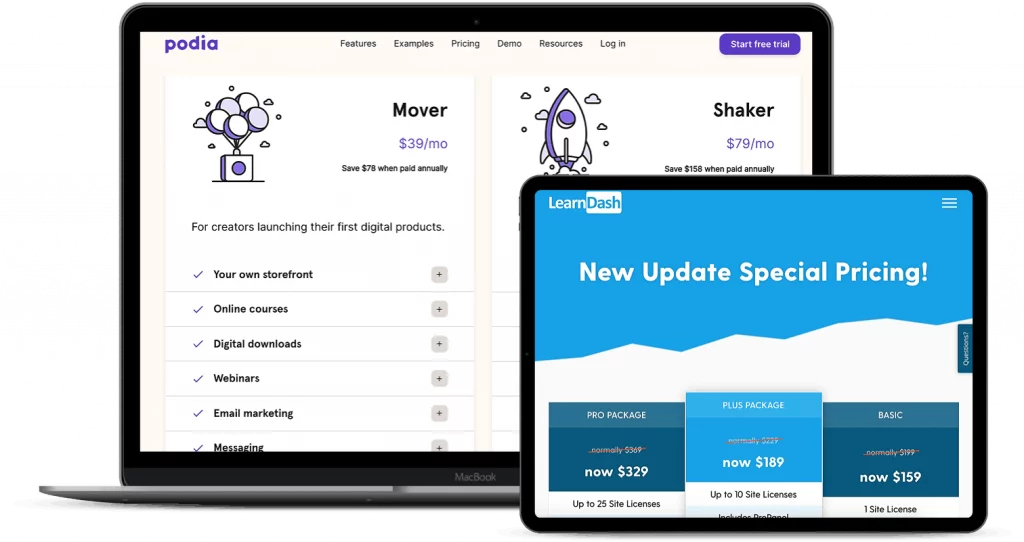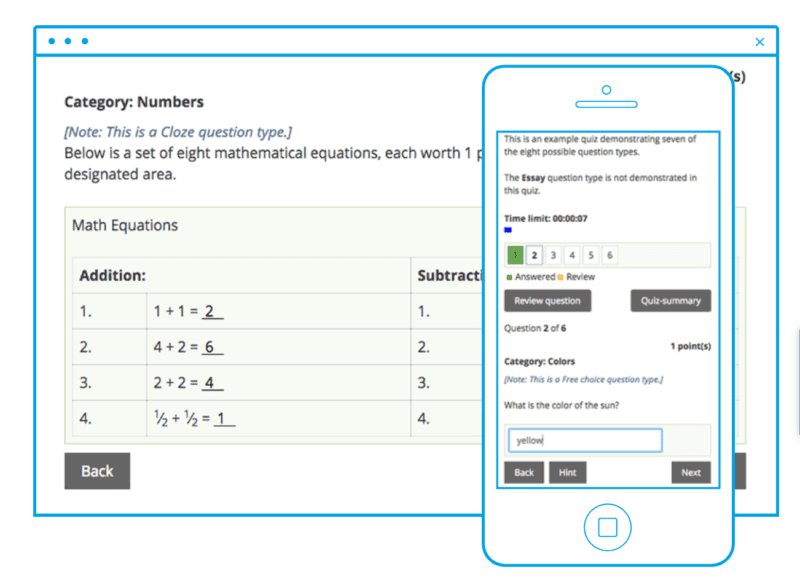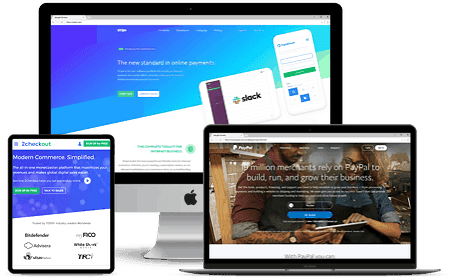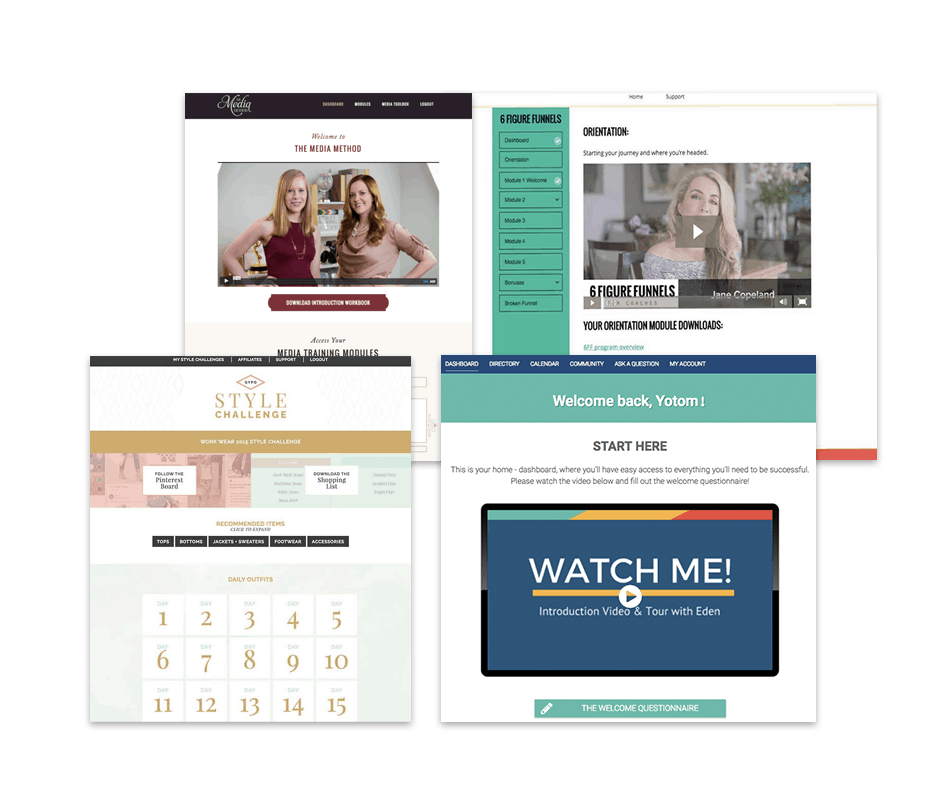Podia vs. LearnDash: a comparison
Are you looking for LMS software? Our detailed comparison of LearnDash vs. Podia will provide an in-depth review of software features, integration options, course design, assessments, pricing models, and options for customer support.
When You Really Care About The Course Experience
We’ve tested so many course software solutions for our business over the years.
When we couldn’t find a solution that would do what we needed, we dusted off our Software Engineering chops and developed AccessAlly.
And to this day, we continue to test and review the options on the market so we can share that knowledge.
How do Podia and LearnDash Differ?
LearnDash and Podia both offer the ability to build online courses, but this is where the similarities end. Let’s explore differences between the two LMS platforms.
All-in-one vs. Dedicated WordPress LMS Plugin
Podia and LearnDash have different software philosophies. LearnDash’s focus is purely on online course creation, whereas Podia has the admirable goal of handling your entire digital business.
Simply put, Podia tries to do too much, especially for the more advanced user or veteran business owner.
Podia is a SaaS solution that will host your main website, take payments, deliver courses, manage memberships, handle marketing automation pipelines, send marketing emails, and design landing pages.
They do it well on a more simplified build and are a good choice to keep costs down if you’re just getting started online.
However, as you grow, we recommend looking into alternatives that include more advanced features and functionality designed to take your memberships and online courses to the next level.
LearnDash is a WordPress plugin and focuses on the Learning Management System (LMS) functionality. This could be advantageous or disadvantageous for you depending on your course goals.
To expand on LearnDash’s core LMS functionality you’ll likely need to install additional WordPress plugins and add-ons to deliver a positive user experience from end to end. Fortunately, LearnDash has a robust marketplace of integrations and add-ons to make this possible.
Unfortunately, that means you may need to purchase and integrate additional plugins to handle:
-
- Payments and payment administration
- Membership levels to run cohesive membership sites
- Integration with your CRM for marketing automation
With Podia, you sign up for one tool that seamlessly handles everything from payments, course creation, LMS functionality, deep integrations, and member management.

Pricing limits on members, courses, and products
Pricing is an important factor in the decision-making process when it comes to choosing the platform or software that will power your membership or online courses.
Here’s a summary of LearnDash’s tier options and site license limits:
-
- Basic: $199 / year – 1 site license
- Plus package: $399 / year – 10 site licenses
- Pro package: $799 / year – unlimited site licenses
In comparison, Podia offers four tiers:
-
- Free $0 / month
- Starter $9 / month
- Mover $39 / month
- Shaker $89 / month ($75 / month after the first year)
The Free and Starter levels have some pretty serious restrictions, including transaction fees (10 and 8% respectively), only one download, one coaching space, and only draft courses and webinars, which their website suggests are for building and developing before you sell.
The Mover tier has 5% transaction fees, but offers unlimited courses, downloads, coaching spaces and webinars, but no affiliate functionality. The Shaker level includes that affiliate function and no transaction fees.
In summary, unless you’re just getting started or run a bare-bones course or membership, you’re mostly likely going to need the Shaker ($89) plan with Podia. If you only need one install, you can budget for the lowest level tier on LearnDash — but you may need additional plugins, which have additional fees.
Extensibility and Ownership
With Podia, you’re hosting your website and courses on their closed platform, with no easy way to take your content with you when you cancel or decide to move on.
Because the Podia system is closed, you can’t easily extend it by installing add-ons and plugins. That means you can’t add metrics or course progress-tracking, gamification, or other features that could improve the overall user experience for your courses.
LearnDash took a different approach: it’s a WordPress plugin so you’re not building your site on rented land. However, when it comes to creating courses, LearnDash uses a proprietary Custom Post Type that allows you to designate modules and lessons. If you cancel your LearnDash license, your content isn’t usable anymore. Fortunately, some plugins, like AccessAlly, can help you retrieve your content and migrate it if you decide to move away from this plugin.
Unlike Podia, LearnDash does provide LMS integrations to extend its core functionality.
However, it’s fairly common for LearnDash users to have 6 or more different plugins to make sure everything works together to create a functional learning experience. When it comes to your tech stack, think long-term, because the more plugins you add, the more risk you assume for things to go wrong.
LearnDash is a great plugin if you only sell one course and don’t require a lot of additional functionality.
Looking for a Alternative With Fewer Restrictions?
You want full control of your content, members, and their experience on your site.
So you can spend your time doing what you do best, not struggling with frustrating platform restrictions.
With AccessAlly, you’ve got all of the power and flexibility of WordPress, without any limits on your business’ growth potential either.
 Get a Free AccessAlly Demo Experience
Get a Free AccessAlly Demo ExperienceWhat AccessAlly Customers Are Saying...

"When Comparing Course Platforms, Look At Both The Leadership And The Software
You guys might be one of the smartest and hardest working platforms out there.
AccessAlly is so so so good. It’s literally at the core of my business!
It really is a pleasure being a customer of AccessAlly.”
– Michael Killen, sellyourservice.co.uk

"Fewer integrations are needed to make it all work
Onboarding and Customer Support
It’s imperative for SaaS and tech companies to have a strong customer support team and system in place to ensure their user’s success, but most companies do customer support differently.
Podia’s customer support is available 24/7 via email and they have live chat hours scheduled 7 days a week. They offer free migrations for annual plan customers and everyone on their “Shaker” tier. They also have an extensive knowledge base to help you with your setup, step-by-step.
In comparison, LearnDash doesn’t have 24/7 support and their email only support hours are Monday-Friday from 7am-4pm EST.
Don’t let this deter you though. We have found that email support is very effective, especially when you have a more complex question to troubleshoot.
It allows the support team time to sort through the issue and confidently provide you with a resolution.
And keep in mind that there tend to be online user groups for most SaaS and LMS companies to get real-time support from existing users.
Integration With Your Email Marketing Automation Platform and Webinars
With Podia, the extent of its integration with your email platform is that you can pass new contacts over to your email system after they sign up on Podia. That’s best described as “one way” integration.
Fortunately, Podia is equipped with built-in email automation so this doesn’t have to be too complicated. On the downside, your design options are limited and it’s more bare-bones than what you get when you use a traditional e-mail marketing system or CRM.
Since this feature is built-in, it makes sense that they haven’t prioritized integrating with other email platforms.
Similarly, with LearnDash, you’ll need a 3rd party tool such as Zapier or WPFusion to connect your online courses built on your WordPress site to pass information back to your CRM.
If you have a more advanced use case, these tools may not be the ideal solution for your business.
Webinar integration is a major win for Podia users. Unlike the majority of online course plugins and SaaS solutions, you have the ability to set up built-in webinar functionality within your online course or membership site powered by YouTube Live.
Podia makes it possible to offer free webinars as part of your sales funnel, easily sell evergreen replays, or host live sessions for your members.
This functionality isn’t available to LearnDash users. However, like on any WordPress website you can embed YouTube Live events and link to a Zoom webinar link. It’s just not an automated process like it is in Podia.
Looking for something that integrates both ways?
Marketing automation tools are here to stay.
Use your marketing automation tool to power your course and membership program by taking advantage of AccessAlly’s deep 2-way street integration.
It’s built to help you sell more, teach better, and engage with your students longer.
Online Learning Through Quizzes, Progress Tracking, Homework, and Certificates
This is where LearnDash really stands out in comparison to Podia.
LearnDash allows you to add a quiz or assessment at any level throughout a course, whether it’s at the end of a course, a specific lesson, or topic.
With 8 question types to choose from, timed assessments, and the ability to submit any type of media as an input field, your assessment options are endless.
You can also require homework submissions after lessons or topics, and issue report cards and track homework and assessments with gradebooks.
LearnDash has even taken their progress-tracking to a new level in their most recent release, tracking course progress across all levels of the course, baked right into the layout.
A great way to motivate students to complete their courses and material is to use LearnDash’s built-in certificates to reward them as soon as they complete a course.
While Podia does allow you to create assessments to reinforce the material and test student retention, your options for quiz and question types aren’t as robust compared to LearnDash. With Podia you are limited to creating multiple choice questions only.
If your online course plans include tracking your students’ progress to make it more engaging and motivating for them to complete, unfortunately you’re out of luck when you use Podia. On a more positive note, Podia does include a live chat component to make it easy for potential and existing customers to reach out directly for live, 1:1 support to increase engagement and retention.

How Flexible Are The Design Options?
For brand-conscious entrepreneurs who value design, Podia may not be for you due to their limited theme customization.
It’s great if you’re just getting started or if you may not be specific about the look and feel of your sites, but it’s not ideal for those who want full design flexibility.
Podia has a drag-and-drop page builder that makes it easy to choose different elements or modules to add to your site. You can set your brand colors, but it’s lacking in the flexibility you have when you build on WordPress to fully customize your design.
Want to change what shows up on a member dashboard? Add a progress bar within a course or profile page? With Podia, you’re out of luck.
On the other hand, LearnDash is an LMS plugin for WordPress, so it integrates with any WordPress theme or builder plugin. Their built-in course layouts and focus mode are compatible with most page builders.
The built-in course builder has a drag-and-drop editor that makes it easy to add your content and re-use lessons or topics from existing courses. However, when it comes to the look and feel of your course pages, it’s lacking in flexibility. Aside from specifying a few colors, you won’t have full customization over the course layout and design.
If you want full design flexibility, AccessAlly is for you
Because AccessAlly is a WordPress plugin, you can use any WordPress theme or builder you like.
Or start with AccessAlly’s theme, which comes with all of the progress tracking and navigation menus integrated out of the box.
Power, flexibility, and beauty all in one course platform.
Handling Group Access or Bulk License Programs
If you want to offer “bulk licenses” or the ability to have umbrella parent/child accounts, where a group leader can assign sub-accounts, say for a corporate training team or family accounts…
Unfortunately, Podia doesn’t offer teams or bulk course enrollment.
An additional plugin that is developed by another company is required to implement this feature with LearnDash, but it is possible.
Running an Affiliate Program and Taking Payments Directly
Podia has built-in Stripe and PayPal integration with coupons using a two-step order form. You can even increase your sales conversions by offering coupons for users and 1-click upsells to increase revenue. If you offer recurring payments or payment plans for your offers on Podia, you will need to process these payments with Stripe, as it’s not available through PayPal on this platform.
Podia also offers affiliate tracking functionality in their Shaker level plans. However, the affiliate feature isn’t as robust as most affiliate management plugins tend to be. If you’re looking for a more advanced affiliate center I recommend looking into alternative solutions.
LearnDash has limited built-in e-commerce functionality, however, if you have a simple setup and only offer one-time payments for courses, no additional plugins are needed and it natively integrates with PayPal, Stripe, and 2checkout.
If you’re selling recurring subscriptions, offering payment plans, and want an easy way to offer upsells and cross-sell your other products, an add-on or additional plugin is needed to achieve this functionality. The same holds true for affiliate features.
This is where the costs and complexity start to add up for LearnDash.

Your workflow on Podia vs. LearnDash:

- Setup your storefront
- Add any connecting applications you might want to use, such as Zapier for integrations
- Choose your URL
- Migrate existing content or add new content to your website pages
- Add integrations such as Google Analytics or Facebook tracking pixel
- Customize the look and feel of your site by using the out-of-the-box editor or building something from scratch
- Build your online courses, digital downloads, memberships, and free or paid webinars.
- Setup your payments and terms of purchase
- Add your emails and marketing automations or integrate with a CRM

- Install the plugin on your WordPress membership site
- Install a payment plugin or purchase an additional shopping cart tool (and possibly an additional affiliate plugin)
- Install a membership plugin, and configure it
- Install or set-up CRM integration plugin, team licensing add-ons, member directory add-ons, etc.
- Dig into your site’s CSS and hack the LearnDash design to match your branding
- Use the LearnDash course builder to design your course structure
- Set up your quizzes, link them to lessons
See How Podia and LearnDash Features Compare
We’re a digital marketing software company built by marketers and software engineers. With our particular background and expertise, we’ve designed AccessAlly to be a robust membership and LMS plugin. AccessAlly’s features will give you everything you need in an easy to use, powerful software package. Let’s extend our LMS comparison to see how LearnDash and Podia compare to AccessAlly.
| Software Feature | AccessAlly | Podia | LearnDash |
|---|---|---|---|
| Protected course content | |||
| Built-in Recurring Stripe and PayPal payments | No recurring with PayPal | ||
| Course builder for modules, lessons, and topics | |||
| Automatically creates tags, pages, and menus | No tags | ||
| Deep 2-Way Integration with Infusionsoft, Ontraport, ActiveCampaign, ConvertKit, and Drip | |||
| Multiple currencies, automated expiring coupons, and order bumps | |||
| Cart abandonment automation | |||
| Progress tracking, and progress-based unlocking content | |||
| Multiple types of quizzes, and auto generated certificates of completion | |||
| Course Licensing with Teams or Umbrella Accounts | With add-ons | ||
| Searchable member directories and editable custom fields through profiles | |||
| Gamification where members can earn points, and activity-based automation, login tracking | |||
| Media player, video bookmarks, tagging automation on quizzes | |||
| Cross-selling dashboards, with 1-click upsells | |||
| Built-in affiliate tracking with multiple tiers, links, and reporting | Not all | ||
| SCORM / Tincan add-ons | Not all |
Researching course platforms on your own is great, but if you want to talk to someone, we're here to help!
If you’re wondering whether you’re on the right track or not, we can help you sort out all of the different options. We’ll let you know if AccessAlly is a good fit or not, too.
We’ll start by asking you a few questions and guide you in the right direction.
The true cost of Podia vs LearnDash
These pricing models will give you an idea of what you can expect, when comparing the cost of Podia vs. LearnDash but it’s not the whole picture.
If you plan to use Podia to handle your email marketing automation, it’s more advantageous to go with this option. If you’ve already got an email marketing automation platform and a website, Podia may still be advantageous based on what add-ons you may need with your LearnDash build.
LearnDash only functions as your Learning Management System (LMS), so keep in mind that you’ll also need to add a payment processor, order forms, membership plugin, website hosting, video hosting, and other add-ons – like groups for forums.
The costs start to add up as you add-on these integrations and features, so keep this in mind as you’re comparing pricing so you’re being mindful of your true investment.
In Summary
Podia might be right for you if...
-
- You need a bare-bones course website, with no plans for added functionality down the line
- You want to have your site up and running quickly, so you can test your ideas without worrying about design
- You don’t use a CRM like Infusionsoft/Keap, Ontraport, ConvertKit, ActiveCampaign, or Drip to do your email marketing automation
- You don’t mind building on rented land and giving up full control to have a website, email marketing, and course platform that handles everything for your membership and online course business in one place
LearnDash might be right for you if...
-
- You are open to a larger tech stack, and using a lot of different plugins to achieve your goals
- You absolutely need SCORM or Tin-Can LMS integration
- You’re not picky about the look-and-feel of your course
- You don’t need deep CRM integration to create more personalized customer experiences, but you do need a lot of quizzing options
Take AccessAlly for a test drive
Get your own free demo sandbox account so you can experience the flexibility AccessAlly has to offer.

Find answers
Didn’t find an answer to your question? Just reach out to us, we’re happy to help!
Do you have comparisons to other platforms and plugins?
Yes, we’ve done the research so you don’t have to. Here are some options to consider:
Can I see examples of AccessAlly sites?
You can find videos and case studies with screenshots and descriptions of how people are using AccessAlly on our showcase page here.
Can I talk to someone about my project?
Researching course platforms on your own is great, but if you want to talk to someone, we’re here to help!
We can help you sort out all of the different options. We’ll let you know if AccessAlly is a good fit or not, too.
Planning to develop an enterprise level program?
We’d love to find out more about your project and find out if AccessAlly is a good fit.
Book a discovery call to start the process, or tell us about your project and select “Enterprise” on our contact form.
